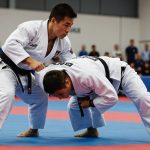Understanding Wind Conditions in Discus Throw
The effect of wind conditions on discus throw is often underestimated. Wind significantly influences the aerodynamics and trajectory of the discus. A headwind slows down the discus, potentially altering its flight path, thus making precision in release critical. On the other hand, a tailwind might carry the discus further, but demands careful control to avoid unintended deviations. Crosswinds are particularly tricky, as they can cause unpredictable deviations, requiring adjustments in technique.
To handle these situations effectively, understanding the specific weather impact is crucial. When facing a headwind, increasing the angle of the release might help counterbalance the slowing effect. In contrast, with a tailwind, a flatter throw could take advantage of the assisting breeze. For crosswinds, minor angle modifications in the direction opposite to the wind help maintain trajectory.
Also to see : Game-changing tactics for athletes to minimize concussion risks in american football
Adapting throwing techniques according to wind scenarios is beneficial. Precise adjustments enhance performance and reduce the chances of fouls. Weather impact awareness, along with proper technique adaptation, allows athletes to optimize their throws and consistently perform at their best, regardless of wind conditions.
Techniques for Mastering Discus Throws
Excelling in discus throw requires a blend of precise mechanics, effective form, and adaptive techniques. Each element plays a crucial role in optimising performance amid varying conditions.
This might interest you : Ultimate guide to preventing muscle cramps for long-distance runners during races
Importance of Grip and Release
The right grip sets the stage for a successful throw. Athletes should aim for a firm yet flexible hold, allowing for smooth release. Proper release techniques are equally essential; they ensure the discus travels on the intended trajectory. An optimal grip coupled with a decisive, clean release directly influences the discus’s flight path and overall distance.
Body Positioning and Footwork
Positioning is pivotal. Maintaining balanced body alignment during the throw enhances force transfer from the body to the discus. Correct footwork, which involves precise pivots and rotations, contributes to a powerful launch, providing consistent results even under shifting weather conditions.
Timing and Rhythm
The harmony between form and technique is evident in timing and rhythm. Adjusting rhythm based on wind patterns can significantly improve throw outcomes. Timing influences not only the distance but also the control one has over the throw. Wind conditions demand minor adjustments in timing, ensuring that the discus’s path is smooth and accurately directed.
Drills for Developing Discus Throw Skills
Effective discus drills are essential for mastering the art of discus throwing under various wind conditions. These drills target specific skills that enhance an athlete’s performance and adaptability.
Targeted Drills for Wind Adaptation
Engaging in targeted drills for wind adaptation is crucial. These exercises allow athletes to practice correct form and adjust their techniques in realistic scenarios. For instance, throwing against a simulated headwind helps athletes refine their release angle to counteract resistance. Practising these conditions ensures competance in navigating unpredictable elements.
Strength and Conditioning Exercises
Incorporating strength and conditioning exercises into training routines enhances overall performance. Building core strength increases stability during the throw, allowing for more effective force transfer to the discus. Exercises such as medicine ball workouts contribute to improved rotational power and endurance.
Incorporation of Video Analysis
Utilising video analysis offers a valuable tool for self-assessment and skill enhancement. Reviewing footage allows athletes to identify areas for improvement, such as footwork or grip. Coaches can provide feedback, enabling athletes to make precise adjustments. This method promotes informed technique refinement and leads to continual progression.
Expert Insights and Testimonials
Engaging insights and real-world experiences can greatly enhance understanding in discus throw strategy, especially concerning wind influences. Athlete testimonials offer personal stories from elite discus throwers who excel in adapting their techniques to different wind conditions. They highlight practical adjustments—like altering release angles or body positioning—tailored to unique weather challenges.
Coaching tips draw upon seasoned expertise. Coaches emphasise the significance of mental resilience in competitive scenarios with variable weather. They recommend focusing on core throwing techniques, suggesting minor timing tweaks based on the wind’s direction and speed to maintain control and maximise distance.
Incorporating expert opinions into training allows athletes to adopt a more comprehensive approach. Experts often advise exploring various discus types and weights to suit specific conditions, suggesting lighter discs for stronger headwinds to maintain stability and trajectory.
Mental preparation is crucial when confronting adverse conditions. Experts underscore that a positive mindset and focus on technique rather than outcomes help athletes thrive under pressure. This approach fosters an environment where athletes can adapt seamlessly, regardless of the external weather.
Safety Measures and Equipment Recommendations
Ensuring safety in discus throw is paramount, especially under blustery conditions. It’s crucial to follow guidelines to prevent accidents. When facing intense winds, maintaining a safe perimeter around the throwing area becomes essential, protecting both athletes and spectators. Proper discus types play a role too, as specific designs cater to particular wind solutions. Lighter discs are ideal in strong headwinds, aiding in stability and trajectory control.
Equipping athletes with appropriate footwear enhances both performance and safety. Shoes offering optimal grip reduce risks of slipping on wet or windy days. Footwear with lateral support also aids in maintaining balance during the throw, vital during sudden wind changes.
Apparel further impacts an athlete’s performance and safety. Wearing breathable, tight-fitting clothes minimises drag and ensures comfortable movement. Hoodies and loose clothing are discouraged as they can interfere with the discus’s flight path.
Adhering to these measures, athletes can focus on refining their performance, secure in the knowledge that they are protected against the elements. Whether training or competing, these precautions aid in developing a resilient mindset, one ready to navigate the nuances of windy climates.




